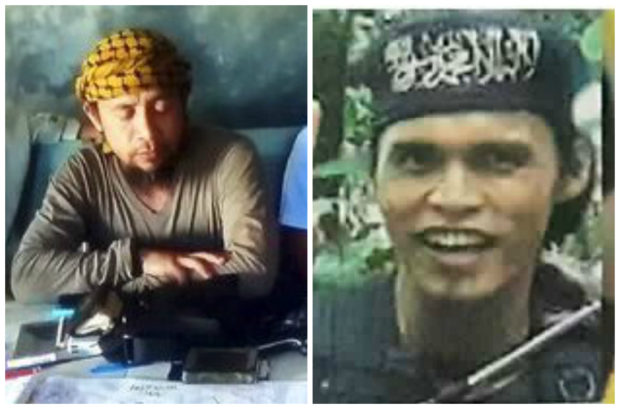
The top leaders behind the months-long war in Marawi Isnilon Hapilon (left) and Omar Maute. AP, INQUIRER FILE PHOTOS
The battle for Marawi may finally be ending with the killing of the last two leaders of the Islamic State-inspired terrorists holed up in the city early on Monday.
Killed in fighting with government troops that started at 2 a.m. and ended at 6 a.m. were Abu Sayyaf leader Isnilon Hapilon and Maute terror group leader Omarkhayam Maute.
Both had pledged allegiance to the Islamic State (IS) group, whose self-proclaimed “caliphate” in Iraq and Syria is crumbling under attack by US-backed Syrian and Iraqi forces.
Hapilon, who is listed among the US Federal Bureau of Investigation’s most wanted criminals, was said to be the “emir” of IS in Southeast Asia.
Hard push
The deaths of the two terrorist leaders came during a hard push by the military to end the nearly four-month siege that had killed more than 1,000 people, displaced more than 400,000 others, and reduced much of Marawi to rubble.
Defense Secretary Delfin Lorenzana confirmed the deaths of Hapilon and Maute.
“Yes, they are confirmed dead,” Lorenzana said, adding the bodies had been recovered by troops and DNA tests would be done on the remains to clear the way for the payment of huge US and Philippine bounties offered for the two terrorist leaders.
The US State Department has offered a reward of up to $5 million for Hapilon, whom Washington blames for the kidnappings of several Americans, one of whom was beheaded in 2001 in Basilan.
Hapilon had been indicted in the District of Columbia for his alleged involvement in terrorist acts against Americans and other foreigners.
The Philippine government has offered a P17.4-million reward for the capture of Hapilon and P5 million for Maute.
Rescued hostage
The military’s informer was a hostage rescued on Sunday.
“Yesterday, we were able to get a testimony from a hostage. She was able to confirm the presence of [Hapilon] and Maute in that particular building. That’s the building that we assaulted early this morning,” Lorenzana said.
He said other Maute group members were also killed in the fighting. Seven bodies had been recovered, including those of the two terrorist leaders, he said.
The troops also rescued 17 hostages, he said.
The deaths of Hapilon and Maute will be a major victory for the military, which has been criticized for its slow progress in retaking Marawi and the ease at which the terrorists laid siege to the city on May 23.
Other terrorist leaders, Maute’s brothers Abdullah and Madi, had been reported killed, though no body had been found to prove their deaths.
Those leaders had been central to the terrorists regrouping, rearming and recruiting after previous clashes over the past two years in Mindanao.
Resilience
The terrorists had surprised the military by their ability to endure more than 130 days of airstrikes, compounding fears in the Philippines and the region that the radical IS ideology and its advanced recruitment methods were more prevalent than was previously imagined.
As of Monday, clashes between the military and the terrorists have killed 822 terrorists, 163 soldiers and policemen, and 47 civilians.
More than 1,700 troops have been wounded in the fighting.
A top Malaysian militant, Mahmud bin Ahmad, who uses the nom de guerre Abu Handzalah and is a close associate of Hapilon, has not been found and is among the remaining terrorists being hunted by the military, Lorenzana said.
With the deaths of Hapilon and Maute, Lorenzana said the end to the Marawi crisis was imminent.
“The indication here is that the Marawi incident is close to the end. We may announce the termination of hostilities in a couple days,” he said.
The government forces were prepared for any “diversion” or “retaliation” by the terrorists, he said.
Lifting martial law
Lorenzana said the lifting of martial law in Mindanao was up to President Rodrigo Duterte.
“We will assess the entire Mindanao if there is a need to recommend to the President the lifting of martial law,” he said.
The military missed an Oct. 15 “target” for the end of the conflict. It had missed a number of previous deadlines, all attributed to caution to avoid harm to the hostages.
Army Col. Romeo Brawner Jr., deputy commander of the military’s Task Force Ranao, said on Sunday that about 40 terrorists were still fighting in a small hilly residential area by Lanao Lake, including 100 relatives of the gunmen and civilian hostages.
On Saturday, troops attempted to rescue several hostages but only snatched a 16-year-old girl because of intense terrorist fire, which wounded an Army battalion commander and 20 other soldiers, Brawner said.
It was that girl who provided the crucial information that allowed troops to locate Hapilon and Maute in one building, Lorenzana said.
Escape attempt
Gen. Eduardo Año, chief of staff of the Armed Forces of the Philippines, said Hapilon and Maute attempted to escape but were cornered by government troops.
“They were attempting to go out to the street to escape. In fact, there were four boats ready on the lake. They had it built by the hostages so they really planned to get out,” Año said.
He said the military had wanted to get the two men alive, but they fought it out with the troops and were killed. —With reports from the wires